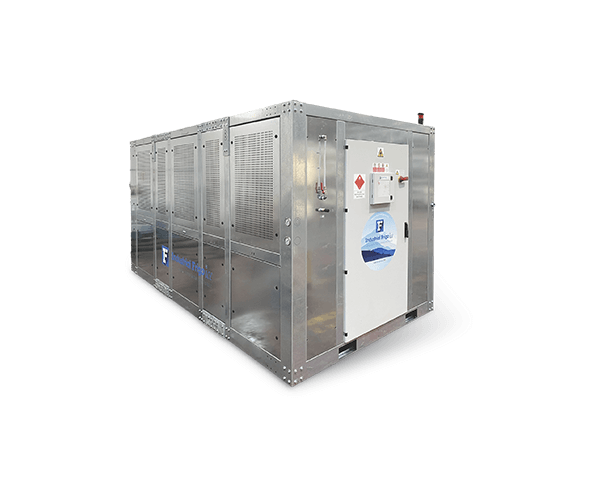Naturally natural
High-Efficiency Chillers with Natural Refrigerants
Eco-friendly refrigeration systems for ice skating rinks
In the face of stricter environmental regulations and rising energy costs, we deliver advanced refrigeration systems using natural refrigerants—specifically engineered for ice rinks and recreational facilities across the U.S.
Our chillers use eco-friendly refrigerants like propane (R-290), ammonia (R-717), and carbon dioxide (R-744), offering high-efficiency performance with a lower global warming potential (GWP). These systems not only help reduce greenhouse gas emissions, but also cut down on long-term operating expenses.
Whether you’re upgrading an existing rink or building a new facility, our sustainable cooling solutions meet U.S. standards for safety, efficiency, and environmental impact. Stay ahead of compliance, reduce your carbon footprint, and enjoy reliable cooling built for the future.

R-290 – Propane
Propane chiller RPP Green Line
An advanced propane-based chiller engineered for optimal performance in ice rinks and sports venues. Designed to deliver significant energy savings and minimize environmental impact, this system uses R-290 — a natural, eco-friendly refrigerant — to provide reliable, high-efficiency cooling.

R-717 – Ammonia
Ammonia chiller IHNW Green Line
This ammonia-based chiller offers outstanding thermodynamic performance, making it an ideal sustainable solution for ice arenas and skating facilities. Utilizing R-717, a natural refrigerant, it delivers exceptional cooling power with low energy usage and a reduced environmental footprint.

R-744 – Carbon dioxide
CO₂ chiller ICO Green Line
Our CO₂ chiller is an environmentally responsible solution for ice sports venues, combining consistent performance with a minimal ecological impact. Powered by R-744—a natural, non-toxic refrigerant—it ensures energy-efficient operation and supports long-term sustainability goals.
Key Factors
Greenhouse Effect
A portion of the sunlight reaching Earth is reflected back into space, while the rest is absorbed and converted into heat. Gases like CO₂ in the atmosphere act as a thermal blanket, trapping this heat and helping maintain a livable temperature on the planet.
Ozone Depletion Potential
ODP refers to how much a substance can damage the ozone layer, which protects life on Earth from harmful ultraviolet radiation. It’s an essential metric used to evaluate the environmental impact of refrigerants and their long-term sustainability.
Global Warming Potential
GWP measures how much a gas contributes to global warming in relation to carbon dioxide, which has a baseline GWP of 1. This indicator looks at the gas’s influence on the greenhouse effect over a 20- or 100-year timeframe, helping assess the overall climate impact of refrigeration systems.
Phasing Out: what you should to know
CFCs & HCFCs
OVERVIEW
Chlorofluorocarbons (CFCs) and hydrochlorofluorocarbons (HCFCs) are chemically stable and non-flammable gases that were once common in cooling and air conditioning systems. While HCFCs are somewhat less damaging than CFCs, both have had serious environmental consequences.
PROBLEM
These substances are known to degrade the ozone layer and also carry moderate to high Global Warming Potential (GWP), contributing to climate change.
REGULATION
CFCs have been completely banned under the Montreal Protocol, while HCFCs are currently under global phase-out programs and are subject to strict regulation.
Phasing Out
F-GASes
OVERVIEW
Fluorinated gases (F-Gases) are man-made compounds used across refrigeration, HVAC, and various industrial sectors. They do not deplete the ozone layer but pose other environmental challenges.
PROBLEM
Although ozone-safe, F-Gases have very high Global Warming Potential (GWP), often thousands of times greater than CO₂. Their emissions contribute significantly to climate change, especially when released through system leaks, improper handling, or disposal.
REGULATION
Due to their climate impact, F-Gases are now heavily regulated, with many countries implementing reduction and phase-out strategies.
Phasing Out
PFAs
OVERVIEW
Per- and polyfluoroalkyl substances (PFAS) are synthetic chemicals prized for their resistance to water, heat, and chemical reactions. They are used in numerous industrial applications, including refrigeration and air conditioning.
PROBLEM
PFAS are known as “forever chemicals” because they do not break down easily in the environment. They tend to accumulate in soil, water, and living organisms, raising increasing concerns about water contamination, ecosystem damage, and long-term health risks such as cancer and hormone disruption.
REGULATION
Their stability makes them difficult to eliminate, and growing awareness of their effects has led to increased scrutiny and regulatory action worldwide.
Phasing Out

